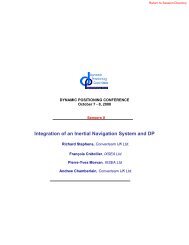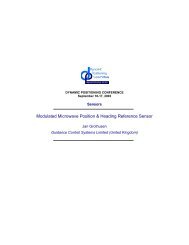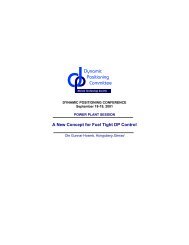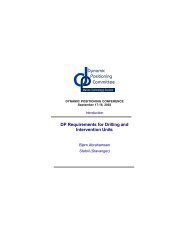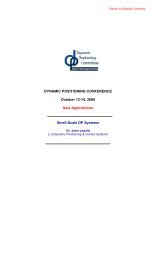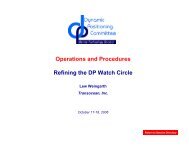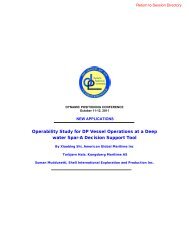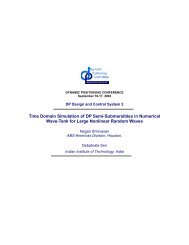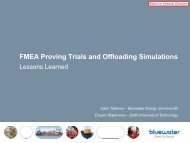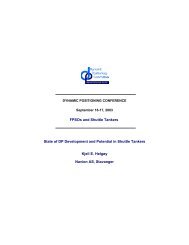WSOG - Dynamic Positioning Committee of the MTS
WSOG - Dynamic Positioning Committee of the MTS
WSOG - Dynamic Positioning Committee of the MTS
You also want an ePaper? Increase the reach of your titles
YUMPU automatically turns print PDFs into web optimized ePapers that Google loves.
Gabriel Delgado-SaldivarThe Use <strong>of</strong> DP-Assisted FPSOs for Offshore Well Testing ServicesDYNAMIC POSITIONING CONFERENCEOctober 17-18, 2006Operations and Procedures<strong>WSOG</strong> – History & Future. A summary <strong>of</strong> <strong>the</strong> Development &Worldwide use <strong>of</strong> Well-Specific Operating GuidelinesAlan AdamsonMENUS, BahrainBjorn AbrahamsenStatoil, Norway
Alan Adamson, MENAS Operations & Procedures <strong>WSOG</strong> – History & FutureTitle: <strong>WSOG</strong> – History & Future. A summary <strong>of</strong> <strong>the</strong> development and worldwide use <strong>of</strong> WellSpecific Operating Guidelines.Author/Presenter:Co-author:Alan Adamson, MENASBjorn Abrahamsen, StatoilIntroductionThis paper discusses <strong>the</strong> issue <strong>of</strong> operational limit setting used in DP operations. It traces <strong>the</strong>history <strong>of</strong> <strong>the</strong> <strong>WSOG</strong> (Well Specific Operating Guidelines) since 1998. The paper also examines<strong>the</strong> reasons behind its widespread use in DP drilling & o<strong>the</strong>r operations.Modern <strong>WSOG</strong> in <strong>the</strong> form we are familiar has its origins with <strong>the</strong> Ocean Alliance campaign in<strong>the</strong> late 90’s on <strong>the</strong> Nyk High, Vema Dome and Helland Hansen prospects in <strong>the</strong> Norwegian Sea.The <strong>WSOG</strong> principle was fur<strong>the</strong>r developed during <strong>the</strong> commissioning <strong>of</strong> <strong>the</strong> drillship WestNavion between 1998-2000. <strong>WSOG</strong> became a cornerstone <strong>of</strong> <strong>the</strong> Statoil DP work requirementsdocument which became <strong>the</strong> principle Corporate DP requirement document, TR1029 in 2000.Since <strong>the</strong>n, a number <strong>of</strong> o<strong>the</strong>r major Operators have introduced corporate DP requirements, all <strong>of</strong>which contain <strong>WSOG</strong> as <strong>the</strong> chosen regime for limit setting <strong>of</strong>fshore.This paper discusses <strong>the</strong> European approach to deepwater drilling risk management in terms <strong>of</strong>limit settings. The paper also discusses 2 incidents. One where <strong>WSOG</strong> worked as intended andone where <strong>WSOG</strong> failed in its objectives. A comparison is undertaken.The paper concludes with a summary <strong>of</strong> <strong>the</strong> reasons <strong>WSOG</strong> has had such widespread use, itsbenefits and introduces challenges to <strong>the</strong> industry to ensure its continued effective use.The presentation at <strong>MTS</strong> in October 2006 will also include a survey among <strong>the</strong> attendees in <strong>the</strong>auditorium. The author will pose a number <strong>of</strong> pointed questions to <strong>the</strong> audience in an attempt togenerate immediate feedback into <strong>the</strong> use <strong>of</strong> <strong>WSOG</strong>. This survey will provide <strong>the</strong> <strong>MTS</strong> DPcommittee with valuable insight into whe<strong>the</strong>r <strong>the</strong> existing <strong>WSOG</strong> process does indeed holdworldwide appeal to <strong>the</strong> industry.<strong>MTS</strong> DP Conference 2000 – Reliability Session, a look back 6 yearsThe subject <strong>of</strong> degraded status is certainly not new. Included is a quote from <strong>the</strong> conclusions <strong>of</strong><strong>the</strong> session on ‘Degraded Status’ given to <strong>MTS</strong> in 2000.DP vessels will frequently be operating with some equipment that is essential for DPclass 2 or 3 unavailable. This can however mean that it is safe to continue working.Thus it is important to make sure each DP vessel has good vessel specific guidelines tomanage a degraded situation and that <strong>the</strong> key DP personnel have enough understanding<strong>of</strong> <strong>the</strong> complete design to determine <strong>the</strong> status correctly. This understanding mustenable logical discussion particularly when several relatively minor items areunavailable because <strong>the</strong>ir sum could be very significant.C. Jenman, Chairman, Global Maritime<strong>Dynamic</strong> <strong>Positioning</strong> Conference October 17-18, 2006 Page 2
Alan Adamson, MENAS Operations & Procedures <strong>WSOG</strong> – History & FutureWhat is <strong>WSOG</strong> ?<strong>WSOG</strong> stands for Well Specific Operating Guidelines. The <strong>WSOG</strong> document is used to defineactions to be taken by a DPO in <strong>the</strong> event <strong>of</strong> certain changes to <strong>the</strong> DP units capability. The<strong>WSOG</strong> also serves as a DP emergency response primer and ‘ready-reckoning checklist’ for DPOperators. A sample form is included herein.The <strong>WSOG</strong>, in a number <strong>of</strong> forms, is used widely across <strong>the</strong> DP drilling industry today. Thelarge majority <strong>of</strong> <strong>the</strong> worlds DP drilling contractors are making use <strong>of</strong> <strong>the</strong> <strong>WSOG</strong> in <strong>the</strong> formatdiscussed in this paper. All DP drilling activities on <strong>the</strong> Norwegian Shelf are conducted using <strong>the</strong><strong>WSOG</strong> regime, and it is <strong>the</strong> primary method <strong>of</strong> conducting <strong>the</strong> station keeping HAZOP and limitsetting exercise.The central tenet <strong>of</strong> <strong>WSOG</strong> is that it clearly defines, prior to operations, <strong>the</strong> 4 different DPoperating status conditions against known possible failure modes. <strong>WSOG</strong> brings toge<strong>the</strong>r <strong>the</strong> rigsdesign basis, changes during design, personnel, clients and so forth.<strong>WSOG</strong> is effectively a purpose built ‘HAZOP’ for DP drilling which, because <strong>of</strong> its designsimplicity, has had a great deal <strong>of</strong> take-up around <strong>the</strong> world. As well as being a simple andeffective tool, it provides <strong>the</strong> following advantages:-• DP Emergency response matrix is defined• Assists training <strong>of</strong> Key personnel without <strong>the</strong> need to re-train across contractors• Brings toge<strong>the</strong>r driller and DPO (drilling and marine)• Brings toge<strong>the</strong>r contractor and client• Shows that <strong>the</strong> contractor has a credible system• Demonstrates a ‘case’ <strong>of</strong> operational risk management• Allows for and is designed for handling change i.e.• New personnel, new equipment, change <strong>of</strong> site, geographic location & clientOne <strong>of</strong> <strong>the</strong> major benefits to <strong>the</strong> DP drilling industry is that drilling supervisors should be able tobuild a body <strong>of</strong> experience when operating on different DP units across different contractors.This was seen by Statoil as a great advantage early on.<strong>WSOG</strong> is, effectively, a link between known failure events & operating conditions <strong>of</strong> differenttype <strong>of</strong> actions. Each ‘action’, green, advisory, yellow and red have defined, agreed responses.The <strong>WSOG</strong> form can be amended and/or expanded to capture additional conditions. The <strong>WSOG</strong>is also valid for use in HAZOPs for operations such as DST and dual activities where additionalsafeguards may need to be applied. The diagram below shows why <strong>the</strong> <strong>WSOG</strong> process works sowell.<strong>Dynamic</strong> <strong>Positioning</strong> Conference October 17-18, 2006 Page 3
Alan Adamson, MENAS Operations & Procedures <strong>WSOG</strong> – History & FutureMap <strong>of</strong> what <strong>WSOG</strong> manages to achieve <strong>of</strong>fshore<strong>Dynamic</strong> <strong>Positioning</strong> Conference October 17-18, 2006 Page 4
Alan Adamson, MENAS Operations & Procedures <strong>WSOG</strong> – History & Future1998: Helland Hansen Prospect (684m, Norske Shell)Wellbore Entry date 28.03.98. Exit 04.07.98Source: PSAStatoil development - 1998The challenge in 1998 was <strong>the</strong> acceptance and compliance issues surrounding <strong>the</strong> entry intoservice <strong>of</strong> <strong>the</strong> Class 3 drillship ‘West Navion’. Within Statoil, a review process began during1998 following <strong>the</strong> Ocean Alliance DP campaign. The DP related verification work including <strong>the</strong>Ocean Alliance Joint Venture Project (Norway) Doc. 1.0 22/09/97 was used as <strong>the</strong> start point.During late 1999, <strong>the</strong> station keeping case for West Navion was accepted by <strong>the</strong> regulator and <strong>the</strong><strong>WSOG</strong> was used from <strong>the</strong> beginning on operations on <strong>the</strong> vessel.Statoil DP Requirements Rev 1B&B-TB-10-20E DP Requirements were issued on 20 January 2000, approved 21 February 2000.The first revision <strong>of</strong> <strong>the</strong> Statoil DP Requirements document mandated an early version <strong>of</strong> <strong>the</strong><strong>WSOG</strong>.Statoil <strong>WSOG</strong> Rev 1 – Feb 2000Statoil Rev 2Following fur<strong>the</strong>r involvement within worldwide asset teams, Statoil published <strong>the</strong> 2 nd edition <strong>of</strong><strong>the</strong> corporate requirements document, entitled WR0581, Version 4 on 29.08.2001.<strong>Dynamic</strong> <strong>Positioning</strong> Conference October 17-18, 2006 Page 6
Alan Adamson, MENAS Operations & Procedures <strong>WSOG</strong> – History & FutureStatoil Rev 3Statoil re-published <strong>the</strong> DP requirements as ‘TR1029’ Technical requirements on early 2002.O<strong>the</strong>r operators such as Norsk Hydro and in 2005, BP, have since issued corporate requirementsfor DP drilling and well intervention.It should be noted that all corporate DP requirements issued by Oil majors use <strong>the</strong> same <strong>WSOG</strong>process as <strong>the</strong> principle means <strong>of</strong> establishing alerts through <strong>the</strong> definitions <strong>of</strong> green, advisory,yellow and red alert.BP GroupBP issued a set <strong>of</strong> Corporate DP requirements for drilling, testing & well intervention in late2004. This finally became Version 8 and was issued in February 2005. The BP standard uses <strong>the</strong>same <strong>WSOG</strong> process as <strong>the</strong> earlier Statoil document. A version 9 is due to be released in <strong>the</strong>summer <strong>of</strong> 2006.Industry PresentationsThe <strong>WSOG</strong> process and wider verification model was presented at <strong>the</strong> IADC Nor<strong>the</strong>rnDeepwater conference in Stavanger in May 2001. The technical paper presented at IADC usedcase studies to show how different Oil Operators and drilling contractors are adopting <strong>the</strong>processes begun in Norway for <strong>the</strong> benefit <strong>of</strong> proving an effective operational risk managementcase for <strong>the</strong>ir DP operations.<strong>Dynamic</strong> <strong>Positioning</strong> Conference October 17-18, 2006 Page 7
Alan Adamson, MENAS Operations & Procedures <strong>WSOG</strong> – History & FutureInfluence on IndustryThe <strong>WSOG</strong> model form has had a significant influence worldwide. On 15 th November 2004,DNV prepared a report for <strong>the</strong> US MMS entitled, ‘Guidance on safety <strong>of</strong> well testing’ Ref. DNV4273776/DNV. The report includes reference to <strong>WSOG</strong> in <strong>the</strong> form presently used.Operators including Shell/Enterprise, BP, ExxonMobil, Conoco, Marathon, Amerada Hess, ElfExploration Angola, Woodside, BHP, Apache have all made use <strong>of</strong> <strong>the</strong> <strong>WSOG</strong> form during <strong>the</strong>irdrilling campaigns. A number <strong>of</strong> drilling contractors have adopted this process, in one form orano<strong>the</strong>r, in <strong>the</strong>ir DP operations manuals.Diamond OffhoreThe following slide shows Diamonds approach. A presentation by Diamond was given at <strong>the</strong>AADE-DIG Meeting in May 2004. It shows that use <strong>of</strong> Advisory and Yellow Alert is crucial.This slide reinforces <strong>the</strong> pointCourtesy Diamond Offshore DrillingA copy <strong>of</strong> a <strong>WSOG</strong> is included herein for sample:<strong>Dynamic</strong> <strong>Positioning</strong> Conference October 17-18, 2006 Page 8
Alan Adamson, MENAS Operations & Procedures <strong>WSOG</strong> – History & Future<strong>Dynamic</strong> <strong>Positioning</strong> Conference October 17-18, 2006 Page 9
Alan Adamson, MENAS Operations & Procedures <strong>WSOG</strong> – History & FutureIncidentsIncidents showing ‘good’ and ‘bad’ use <strong>of</strong> <strong>WSOG</strong>. The following trees represent 2 events whichhave occurred during deepwater DP drilling. They are used to highlight two separate occurrenceswhere <strong>WSOG</strong> use were factorsIncident 1Class 3 semisub in operationNo <strong>WSOG</strong> and incorrectly defineddegraded conditionsBlackout occursMajor investigation Helicopters fill<strong>the</strong> sky. >10 personnel join rigFull HAZOP using blank <strong>WSOG</strong> form wi<strong>the</strong>veryone involved>15 hrs <strong>of</strong> ‘negotiations’ between RigOwner, crew, consultants and Operator<strong>WSOG</strong> for drilling & DST agreedEveryone happy & consent to drill givenbased upon <strong>WSOG</strong> agreed limitsDiscussionThis incident shows that <strong>the</strong> process itself was used as <strong>the</strong> HAZOP. All 84 boxes were discussedjointly between <strong>the</strong> Contractor, crew and Oil Company and a number <strong>of</strong> representatives.Everyone was happy that <strong>the</strong> exercise was valuable and <strong>the</strong> rig went back to work. It wasinteresting that some <strong>of</strong> <strong>the</strong> boxes within <strong>the</strong> <strong>WSOG</strong> took many hours <strong>of</strong> discussion to complete.How did <strong>the</strong> DP Operator cope ‘in operation’ when <strong>the</strong> debate took such a long time during ameeting. Question.<strong>Dynamic</strong> <strong>Positioning</strong> Conference October 17-18, 2006 Page 10
Alan Adamson, MENAS Operations & Procedures <strong>WSOG</strong> – History & FutureIncident 2Class 3 DP drilling<strong>WSOG</strong> in place & agreed/signed + ClientLoss <strong>of</strong> auto heading. Unknown causeLoss <strong>of</strong> position > agreed in <strong>WSOG</strong> for ‘Red’Vessel keeps working with minor nonconsequentialreport4 weeks laterIdentical incident as 4 weeks earlier. Autoheading loss >80 degrees. Major incident &disconnection with accidentFull HSE investigation leads to investigation <strong>of</strong>event 4 weeks earlier. Terms <strong>the</strong> failure tooperate correct limits as ‘missed opportunity’.Continued ‘correct’ use <strong>of</strong> <strong>WSOG</strong>re-iterated to OperatorSource: UK HSE & AAIBDiscussionThis incident shows that, even when <strong>the</strong> correct process has been followed, <strong>the</strong>re can be nosubstitute for effective training and experience aboard <strong>the</strong> unit. The major error made in <strong>the</strong>incident detailed above was <strong>the</strong> failure to follow <strong>the</strong> process detailed in <strong>the</strong> agreed <strong>WSOG</strong>.Incident investigationDuring investigating any LOP (loss <strong>of</strong> position) event or blackout even with no LOP, mostinvestigators would immediately ask for <strong>the</strong> limits in place & <strong>the</strong> operating mode leading up to<strong>the</strong> event.<strong>Dynamic</strong> <strong>Positioning</strong> Conference October 17-18, 2006 Page 11
Alan Adamson, MENAS Operations & Procedures <strong>WSOG</strong> – History & FutureAdditional Uses <strong>of</strong> <strong>WSOG</strong>The <strong>WSOG</strong> alert and reporting regime have been, and are in use on well intervention unitsRegalia, Seawell and Island Frontier, working for Statoil in <strong>the</strong> North Sea.The DP Floatel industry in <strong>the</strong> Norwegian Sector has developed FOGS (Floatel OperatingGuidelines) along <strong>the</strong> same principles as <strong>WSOG</strong>.In addition Statoil are currently working on updated requirements for moored units due to <strong>the</strong>large number <strong>of</strong> incidents with dropped chains and dragged anchors. The group is proposing<strong>WSOG</strong> principles to be implemented on moored units as an efficient early warning and HAZOPtool. The non-DP moored unit sector in <strong>the</strong> US may well find advantages in this approach.<strong>Dynamic</strong> <strong>Positioning</strong> Conference October 17-18, 2006 Page 12
Alan Adamson, MENAS Operations & Procedures <strong>WSOG</strong> – History & FutureConclusions1. <strong>WSOG</strong> has proved that it has an important role to play in <strong>the</strong> establishment <strong>of</strong> safe workingpractices for <strong>of</strong>fshore drilling units. There are a great number <strong>of</strong> lessons to be captured fromits use.2. Effective operating limits must be agreed between <strong>the</strong> contractor and operator at ‘pre-spud’ inorder to avoid confusion caused by contractual arrangements <strong>of</strong>fshore.3. <strong>WSOG</strong> allows for all manner <strong>of</strong> ‘change’.4. In US GOM, some operators view Advisories as ‘crucial’ <strong>the</strong>refore fundamentally supporting<strong>the</strong> use <strong>of</strong> <strong>WSOG</strong>.5. <strong>WSOG</strong> clearly works equally well with drillships and semisubs.6. Has had a degree <strong>of</strong> take-up in o<strong>the</strong>r non drilling DP sectors such as floatel market.7. The concept <strong>of</strong> lessons learnt and continual improvement is allowed using this procedurewhich must be embraced & continued.8. Having drilling personnel ‘trained’ in one process has great appeal to Oil Majors. It meansthat experience can build between rigs/ships <strong>of</strong> different contractors.9. Contractors must accept that Operators have a vested interest in operational risk issues.(Procedures, reporting). This will always increase because station keeping incidents willcontinue.10. The use <strong>of</strong> Advisory to handle changes in <strong>the</strong> units operating status from Non-DP changes isideal. I.e. Pseudo Oil Based Mud / riser displacement timings. Non-shearable exposuretimings.11. History has shown that by having a mature <strong>WSOG</strong> system aboard, this will satisfy OilOperators & regulators verification processes.12. <strong>WSOG</strong> eliminates negative reporting if followed correctly. Ref. Incident No. 213. Limit setting HAZOP should take place prior to each well. (Even if everything is <strong>the</strong> same)14. There must be consensus following <strong>the</strong> <strong>WSOG</strong> limit setting exercise & ‘sign-<strong>of</strong>f’.15. The limit setting exercise should involve, as far as possible, personnel who have workingknowledge <strong>of</strong> <strong>the</strong> rigs operating criteria. The supply <strong>of</strong> experienced & competent crew iscentral here and fur<strong>the</strong>r re-enforces worries in <strong>the</strong> industry.16. Incorrect figures placed in <strong>WSOG</strong> can make <strong>the</strong> DP drilling less safe. There have beenincidents caused by incorrect figures.17. Is ideal tool for HAZOP and has been successfully used in o<strong>the</strong>r ‘non drilling’ DP scenarios18. Norway is advancing <strong>the</strong> <strong>WSOG</strong> concept for use in moored operations as a early warningHAZOP process.19. There has been a large ‘take-up’ <strong>of</strong> this simple form since 1999 which should indicate that <strong>the</strong>process works.<strong>Dynamic</strong> <strong>Positioning</strong> Conference October 17-18, 2006 Page 13
Alan Adamson, MENAS Operations & Procedures <strong>WSOG</strong> – History & FutureReal-time feedback SurveyThe paper presentation concludes with an open questionnaire to all participants in <strong>the</strong> hall(audience). The authors, with <strong>the</strong> help <strong>of</strong> <strong>the</strong> <strong>MTS</strong> committee, would like to conduct a poll <strong>of</strong> <strong>the</strong>audience with <strong>the</strong> following 4 questions:-1. How many people (in DW drilling) know about <strong>WSOG</strong> in limit setting regimes? (count)2. How many people use <strong>the</strong>m on <strong>the</strong>r rigs/ships as policy? (count)3. How many people present believe that <strong>WSOG</strong> (in its present form) works well for <strong>the</strong>iroperation? (count)4. How many people wish to change <strong>the</strong> present method <strong>of</strong> limit settings for something else?(count)The authors propose noting <strong>the</strong> response figures in order to allow <strong>the</strong> <strong>MTS</strong> DP committee to use<strong>the</strong> data in fur<strong>the</strong>r debate on <strong>the</strong> limit setting issue.POST CONFERENCE ANALYSISThe questionnaire took place and <strong>the</strong> following represents <strong>the</strong> findings. We estimated a total <strong>of</strong>about 75 personnel were present for <strong>the</strong> survey.1. How many people (in DW drilling) know about <strong>WSOG</strong> in limit setting regimes?ANSWER =192. How many people use <strong>the</strong>m on <strong>the</strong>ir rigs/ships as policy? (count) ANSWER =133. How many people present believe that <strong>WSOG</strong> (in its present form) works well for <strong>the</strong>iroperation? (count) ANSWER =144. How many people wish to change <strong>the</strong> present method <strong>of</strong> limit settings for something else?(count) ANSWER = NILTherefore, 68% <strong>of</strong> personnel involved in DW drilling have <strong>WSOG</strong> as Policy. 74% approve <strong>of</strong> <strong>the</strong><strong>WSOG</strong> as it works well. 0% wish to change <strong>the</strong> limit setting regime in place.Alan AdamsonBahrain26 th October 2006Adamson@menas.com.bh<strong>Dynamic</strong> <strong>Positioning</strong> Conference October 17-18, 2006 Page 14



